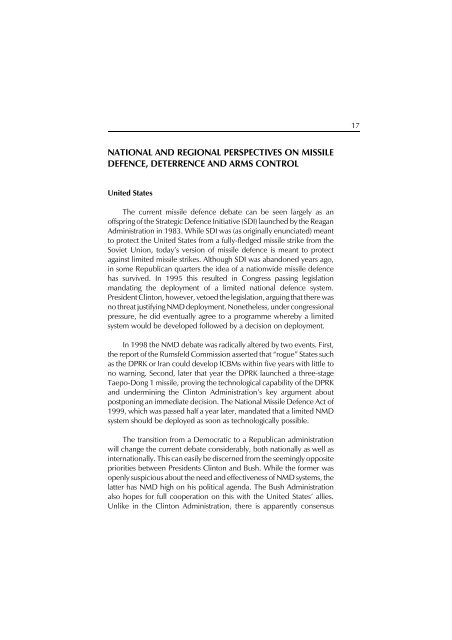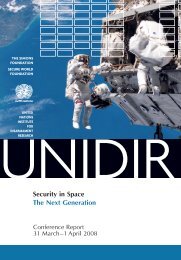Missile Defence, Deterrence and Arms Control - UNIDIR
Missile Defence, Deterrence and Arms Control - UNIDIR
Missile Defence, Deterrence and Arms Control - UNIDIR
You also want an ePaper? Increase the reach of your titles
YUMPU automatically turns print PDFs into web optimized ePapers that Google loves.
6<br />
to simple liquid fuel. Depending on the range of the missile, the boost<br />
phase of a ballistic missile is designed to accelerate the warhead to<br />
velocities upwards of 6-8 km/s in order to reach high endo-atmospheric<br />
or low exoatmospheric orbit, which is the second phase of ballistic<br />
missile flight. The crucial note about the boost phase is that it is the only<br />
stage during which the ballistic missile’s rocket motors are burning,<br />
leaving a distinct signature plume that allows detection <strong>and</strong> tracking.<br />
However, since the booster rockets only have to place the warhead in<br />
orbit in the exoatmosphere (no more than 200 km above the earth), the<br />
duration of the boost phase is only between two to five minutes<br />
depending on the range of the missile. 4<br />
Midcourse Phase<br />
The second phase of the missile flight, also known as the midcourse<br />
of the ballistic missile trajectory, is where the warhead separates from the<br />
rocket booster <strong>and</strong> moves under its own momentum <strong>and</strong> under the force<br />
of gravity. For ballistic missiles with a greater range than 600 km, the<br />
midcourse of the missile trajectory is in the exoatmosphere—in the low<br />
exoatmosphere (approximately 250 km high) for IRBMs <strong>and</strong> in the high<br />
exoatmosphere (approximately 1,300 km high) for ICBMs. In both cases,<br />
the warhead cools to sub-zero temperatures as it arcs through lower<br />
outer space, reaching the apex of its parabolic path before beginning its<br />
descent in the third phase of the flight path: atmospheric re-entry. For<br />
defensive considerations, it is essential to note that the midcourse of the<br />
ballistic missile flight path unfolds in a cold zero-gravity, zero-air<br />
resistance environment, where a feather moves at the same rate as a<br />
warhead. This affords the offence enormous advantages for it can deploy<br />
decoys, e.g. mylar balloons, that look like <strong>and</strong> act like warheads in such<br />
an environment, thus placing enormous—perhaps<br />
insurmountable—sensory burdens on the intercepting vehicle. However,<br />
this phase of the missile trajectory is by far the longest, ranging from<br />
about 10 minutes for IRBMs to over 20 minutes for ICBMs.<br />
4<br />
For example, an SRBM with a range of 600 km has a boost phase lasting<br />
90 seconds, an IRBM with a range of 3,000 km has a boost phase of<br />
120 seconds, <strong>and</strong> an ICBM with a range of 10,000 km has a boost phase<br />
of 300 seconds.








